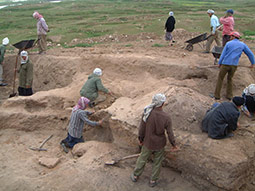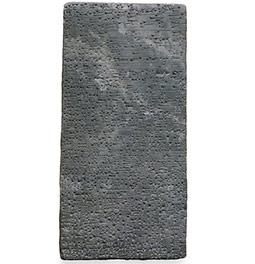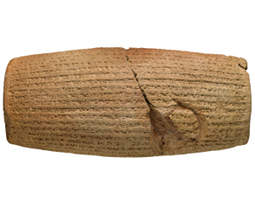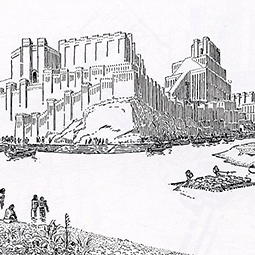Aššur, divine embodiment of Assyria
The Assyrians' home city was Assur, 72 km (45 miles) south of Kalhu on the Tigris river. It was so important to Assyrian self-identity that it was also considered to be a god. Indeed, in cuneiform TT script the only difference between writings of the three words are the determinatives for "land", "city" or "place", and "deity". Because the god Aššur was so closely identified with Assur the city, however, he had barely any presence at Kalhu, except in relation to the king.
Aššur the deified city
The city of Assur PGP was founded in the early third millennium BC on a rocky escarpment which deflected the course of the river Tigris PGP eastwards around it. The height of this promontory and steepness of its sides meant from the top of it one could see for miles across the surrounding plain, while it was easy to defend should invaders attack. Aššur's temple Ešarra PGP ("Temple of the Universe") was located at its very highest, northernmost point (Image 1). It undoubtedly dates back to the first years of the city, although archaeologists who excavated there in 1909 struggled to make sense of the earliest remains (2).
Aššur's ziggurat TT stood immediately to the west of his temple, a little further down the escarpment. Next to that was the so-called Old Palace PGP , which was rebuilt many times over the millennia. This had been the Assyrian royal family's primary residence before Assurnasirpal moved out to Kalhu. The tombs below the palace continued to receive the bodies of deceased kings right until the end of empire, as they were returned to the heart of Assyria. The building above thus remained incredibly important to royal ideology too.

Image 2. Iraqi excavations of a house in the city of Assur. View large image (319 KB). Photo: Eleanor Robson.
During the second millennium BC other deities acquired temples on the lower reaches of Assur's rocky slopes. Anu PGP and Adad PGP shared a building, as did Sin PGP and Šamaš PGP . Ištar PGP had had a residence here for as long as Aššur himself, while Nabu did not gain a home of his own until very late in the 7th century. This 40 hectare sacred precinct, known as the Inner City, libbi āli (literally, "city centre"), also contained the households of Assur's—and Assyria's—most elite families (Image 2).
Shalmaneser III enclosed the Inner City with a defensive double wall, controlling access through gates to the west, southwest and south. Where the outer wall curved south to encompass the lower New City, ālu eššu, early twentieth-century archaeologists found around 140 monumental stone stelae TT dedicated to Assyrian kings and officials. These stelae were not, as once supposed, erected there to form a sort of processional way. Instead, it is likely that they were originally dedicated to Aššur in his temple on the mount. That building did not have room for every single one of them, so over the centuries the oldest ones were respectfully moved out to make way for others, and left where they could be seen and not neglected (3).
The Assyrian king: Aššur's right-hand man

Image 3. Stone slab commemorating the restoration of Assur's temple by king Adad-nerari I, c.1300 BC-1275 BC. BM 90978. View large image on British Museum website © The Trustees of the British Museum.
From the early centuries of the second millennium BC, rulers of the city of Assur called themselves iššiakki Aššur, "vice-regent of the god Aššur" (4). This royal title remained in continuous use right through to the end of empire in the 7th century BC. Its message was simple: the god had chosen the king to rule on his behalf. Everything the king did was for the further glorification of his god and empire, and was carried out with divine blessing. Conversely, losing Aššur's favour and losing political power were one and the same thing.
For much of the 13th to 10th centuries BC—the so-called Middle Assyrian TT period—many kings took throne names with Aššur as one element: Aššur-dan, "Aššur is strong", for instance, or Aššur-nerari, "Aššur is my ally". Three different kings took this first name, another five took the second. While Middle Assyrian royal Aššur-names emphasise the god's strength and power, in the first millennium they tend to focus on his continuation of the royal line: Assurnasirpal II (Aššur-naṣir-aplī, "Aššur is the protector of my heir"), Esarhaddon (Aššur-ahhe-iddin, "Aššur gave brothers") and Assurbanipal (Aššur-bani-aplī "Aššur is the creator of my heir").
Every Assyrian king showed his devotion and debt to Aššur in royal inscriptions. Here for instance, is a passage from an inscription of Shalmaneser III found at Fort Shalmaneser:
When Asšur, the great lord, chose me in his steadfast heart (and) with his holy eyes and named me for the shepherdship of Assyria, he put in my grasp a strong weapon which fells the insubordinate, he crowned me with a lofty crown, (and) he sternly commanded me to exercise dominion over and to subdue all the lands insubmissive to Aššur (5).
Every Assyrian king who could afford it also maintained or improved Aššur's temple in Assur in some way, even those who were mainly concerned with building projects elsewhere (Image 3). Assurnasirpal II PGP , for instance, restored five of the temple's gateway towers (6).
The Assyrian king showed his accountability to Aššur by commissioning reports to the god on the outcome of major military campaigns. The only known survivor is Sargon II's famous report on his eighth campaign, to Muṣaṣir PGP and Urartu. Fragments of Aššur's responses to other royal reports, however, show that this practice ran from at least the reign of Šamši-Adad V PGP to that of Assurbanipal, a period of around a hundred years (SAA 3: 41–47).
A divine enigma: Aššur in Assyrian scholarship
Aššur, as the divine embodiment of a city and it empire, is fundamentally different from any other Mesopotamian god. He appears in no known narrative myths, even as a minor character, as he was rarely conceptualised in anthropomorphic TT terms.
This apparent lack of divine personality seems to have become increasingly problematic for Assyrian scholars TT , especially once Babylonian gods such as Ninurta and Nabu started gaining importance. The early second-millennium ruler Šamši-Adad I PGP equated Aššur with Ellil PGP , who at that time was still head of the Babylonian pantheon. He even tried rebranding Aššur's temple in Assur as Enlil's temple Ekur PGP , after the latter's home in Nippur PGP (7). While the idea that this was Enlil's temple didn't stick, the name did, and Ekur became an alternative to Ešarra. Similarly, Aššur became the Assyrian Enlil (retaining a separate identity, never being completely subsumed as Šamši-Adad seems to have wanted). He took on the same family relationships as Ellil too, with Mullissu PGP (a name of Ninlil PGP ) as his spouse and Ninurta PGP as his son. In this way Aššur became more comprehensible, and better integrated with the rest of Mesopotamian theology.
This re-imagining of Aššur remained a stable element of Assyrian religion even after Enlil's power waned in Babylonia in favour of the new national god Marduk PGP . Assyria's political relationship with Babylonia was never easy. Assyria tended to have the upper hand militarily but this went hand-in-hand with a strongly felt cultural inferiority complex. In the early seventh century Sennacherib, the most vehemently anti-Babylonian of all Assyrian kings, set his mind to destroying Babylonia as a political and cultural force for ever. A key component of this mission was not only to destroy Marduk PGP and his temple in Babylon PGP but to replace him with Aššur in myth and cult. It was in many ways a more violent reversal of Samši-Adad's Aššur-as-Ellil policy of a thousand years before.
Aššur could not, by definition, leave his city. So in Assur, or rather just outside it, Sennacherib commissioned an akītu TT -temple so that Aššur could perform the New Year Festival TT instead of Marduk in Babylon (RINAP Sennacherib 37). His scholars rewrote the Babylonian epic Enūma Eliš that was always performed on this occasion, so that it was Aššur who defeated the forces of chaos and created the world as we know it. The city of Babylon became the similar-sounding Baltil, a scholarly name for Assur. In a separate move, a new learned commentary now known as the Marduk Ordeal (SAA 3: 34, 35) reimagined the New Year Festival as Marduk's ultimate humiliation (8).
This new theology did not stick, however. Sennacherib's son Esarhaddon PGP dramatically overturned his father's Babylonian policy and restored Marduk to his throne. Aššur reverted to his former Ellil-esque self as if the interlude had never happened, for instance in King Assurbanipal's Hymn to Aššur ( SAA 3: 1).

Image 4. A clay cylinder of the Persian king Cyrus from Babylon, also known as the Cyrus Cylinder. This foundation deposit presents Cyrus as a ruler in the traditional Babylonian mould by celebrating his rebuilding of old temples, the repatriation of displaced peoples and the king's restoration of divinely-sanctioned order. A full translation is available on the British Museum website. BM 90920. View large image on British Museum's website. © The Trustees of the British Museum.
After the fall: post-Assyrian Aššur
The city of Assur and its temples were destroyed by the invading Medes PGP and Babylonians PGP in 614 BC. But that was not the end of Aššur and his cult. A significant number of his priests managed to flee the city and resettle in the Babylonian city of Uruk PGP , where they re-established his cult in the temple Eanna PGP (9). This worked because the name of Aššur could on occasion be written with the logogram dAN.ŠÁR, as could the name of Uruk's city god Anu PGP . The two deities were to some degree compatible then, if not exactly identical.
Recently, Karen Radner has convincingly argued that the Persian TT king Cyrus the Great PGP (r.539–530 BC), on his conquest of Babylonia, allowed Aššur to return to his rebuilt temple in Assur (10). She points to the fact that the famous Cyrus Cylinder (Image 4) counts Assur amongst the cities to which:
I (Cyrus) returned the images of the gods, who had resided there [i.e., in Babylon], to their places and I let them dwell in eternal abodes. I gathered all their inhabitants and returned to them their dwellings.
As Radner also points out, the archaeological evidence likewise suggests that Aššur's shrine was partially restored at this time. Graffiti in Aramaic show that residents of Assur continued to take names such as Ahi-Aššur, "Aššur is my brother" well into the third century AD (11). He thus outlasted the empire founded in his name by at least a thousand years.
18 Dec 2019References
- Andrae, W., 1977. Das wiedererstandene Assur, 2nd ed., ed. B. Hrouda, Munich: Beck, p. 54. (Find in text ^)
- Harper, P.O., E. Klengel-Brandt, J. Aruz and K. Benzel (eds.), 1995. Assyrian Origins: Discoveries at Ashur on the Tigris. Antiquities in the Vorderasiatisches Museum, Berlin, New York: Metropolitan Museum of Art. (Free PDF available via Metropotamian Museum of Art Publications), p. 37. (Find in text ^)
- Miglus, P., 1984."Another look at the 'Stelenreihen' in Assur", Zeitschrift für Assyriologie 74: 133–41. (Find in text ^)
- Grayson, A.K., 1987. Assyrian Rulers of the Third and Second Millennia BC (to 1115 BC) (Royal Inscriptions of Mesopotamia. Assyrian Periods. Volume 1), Toronto: University of Toronto Press, p. 3. (Find in text ^)
- Grayson, A.K., 1996. Assyrian Rulers of the Early First Millennium BC II (858-745 BC) (Royal Inscriptions of Mesopotamia. Assyrian Periods. Volume 3), Toronto: University of Toronto Press, pp. 8, A.0.102.1, 11-13. (Find in text ^)
- Grayson, A.K., 1991. Assyrian Rulers of the Early First Millennium BC: I (1114-859 BC) (Royal Inscriptions of Mesopotamia. Assyrian Periods. Volume 2), Toronto: University of Toronto Press, pp. 386, A.0.101.138. (Find in text ^)
- Grayson, A.K., 1987. Assyrian Rulers of the Third and Second Millennia BC (to 1115 BC) (Royal Inscriptions of Mesopotamia. Assyrian Periods. Volume 1), Toronto: University of Toronto Press, pp. 49, A.0.49.1. (Find in text ^)
- Frahm, E., 2010. "Counter-texts, commentaries, and adaptations: politically motivated responses to the Babylonian Epic of Creation in Mesopotamia, the Biblical world and elsewhere", Orient 45: 3–33, pp. 8-13. (Find in text ^)
- Beaulieu, P.-A., 1997. "The cult of AN.ŠÁR/Aššur in Babylonia after the fall of the Assyrian empire", State Archives of Assyria Bulletin 9: 55-73. (Find in text ^)
- Radner, K., 2104. "A godforsaken country: Assyria after 614 BC", inaugural lecture at University College London, 4 March 2014. (Find in text ^)
- Parpola, S., 2004. "National and ethnic identity in the Neo-Assyrian empire and Assyrian identity in post-empire times", Journal of Assyrian Academic Studies 18/2, 5-49, pp. Appendix IV. (Find in text ^)
Further reading
- Lambert, W.G., 1983. "The god Aššur", Iraq 45: 82-86 (PDF available via JSTOR for subscribers).
- Driel, G. van, 1969. The Cult of Aššur (Studia Semitica Neerlandica 13), Assen: Van Gorum.
Eleanor Robson
Eleanor Robson, 'Aššur, divine embodiment of Assyria', Nimrud: Materialities of Assyrian Knowledge Production, The Nimrud Project at Oracc.org, 2019 [http://oracc.museum.upenn.edu/nimrud/ancientkalhu/thepeople/ashur/]
